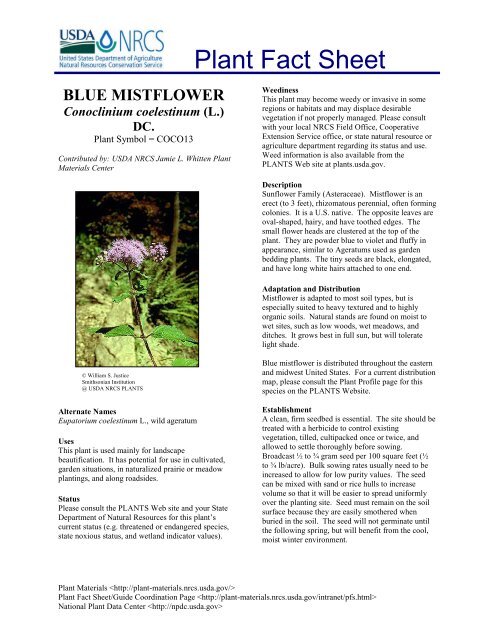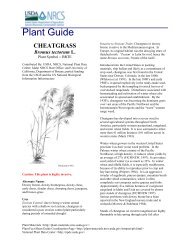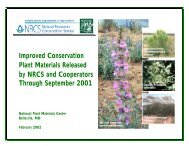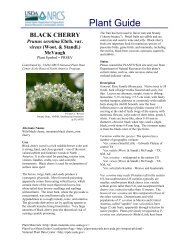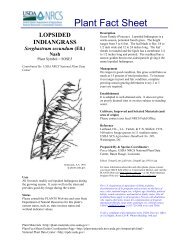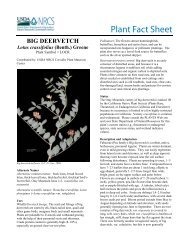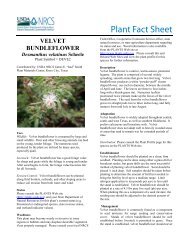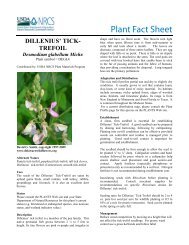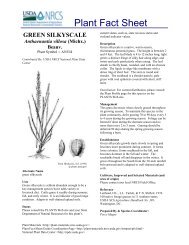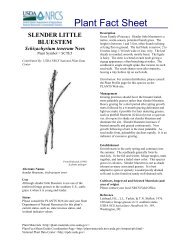BLUE MISTFLOWER Conoclinium coelestinum (L.) DC.
BLUE MISTFLOWER Conoclinium coelestinum (L.) DC.
BLUE MISTFLOWER Conoclinium coelestinum (L.) DC.
Create successful ePaper yourself
Turn your PDF publications into a flip-book with our unique Google optimized e-Paper software.
<strong>BLUE</strong> <strong>MISTFLOWER</strong><br />
<strong>Conoclinium</strong> <strong>coelestinum</strong> (L.)<br />
<strong>DC</strong>.<br />
Plant Symbol = COCO13<br />
Contributed by: USDA NRCS Jamie L. Whitten Plant<br />
Materials Center<br />
© William S. Justice<br />
Smithsonian Institution<br />
@ USDA NRCS PLANTS<br />
Alternate Names<br />
Eupatorium <strong>coelestinum</strong> L., wild ageratum<br />
Uses<br />
This plant is used mainly for landscape<br />
beautification. It has potential for use in cultivated,<br />
garden situations, in naturalized prairie or meadow<br />
plantings, and along roadsides.<br />
Status<br />
Please consult the PLANTS Web site and your State<br />
Department of Natural Resources for this plant’s<br />
current status (e.g. threatened or endangered species,<br />
state noxious status, and wetland indicator values).<br />
Plant Fact Sheet<br />
Weediness<br />
This plant may become weedy or invasive in some<br />
regions or habitats and may displace desirable<br />
vegetation if not properly managed. Please consult<br />
with your local NRCS Field Office, Cooperative<br />
Extension Service office, or state natural resource or<br />
agriculture department regarding its status and use.<br />
Weed information is also available from the<br />
PLANTS Web site at plants.usda.gov.<br />
Description<br />
Sunflower Family (Asteraceae). Mistflower is an<br />
erect (to 3 feet), rhizomatous perennial, often forming<br />
colonies. It is a U.S. native. The opposite leaves are<br />
oval-shaped, hairy, and have toothed edges. The<br />
small flower heads are clustered at the top of the<br />
plant. They are powder blue to violet and fluffy in<br />
appearance, similar to Ageratums used as garden<br />
bedding plants. The tiny seeds are black, elongated,<br />
and have long white hairs attached to one end.<br />
Adaptation and Distribution<br />
Mistflower is adapted to most soil types, but is<br />
especially suited to heavy textured and to highly<br />
organic soils. Natural stands are found on moist to<br />
wet sites, such as low woods, wet meadows, and<br />
ditches. It grows best in full sun, but will tolerate<br />
light shade.<br />
Blue mistflower is distributed throughout the eastern<br />
and midwest United States. For a current distribution<br />
map, please consult the Plant Profile page for this<br />
species on the PLANTS Website.<br />
Establishment<br />
A clean, firm seedbed is essential. The site should be<br />
treated with a herbicide to control existing<br />
vegetation, tilled, cultipacked once or twice, and<br />
allowed to settle thoroughly before sowing.<br />
Broadcast ½ to ¾ gram seed per 100 square feet (½<br />
to ¾ lb/acre). Bulk sowing rates usually need to be<br />
increased to allow for low purity values. The seed<br />
can be mixed with sand or rice hulls to increase<br />
volume so that it will be easier to spread uniformly<br />
over the planting site. Seed must remain on the soil<br />
surface because they are easily smothered when<br />
buried in the soil. The seed will not germinate until<br />
the following spring, but will benefit from the cool,<br />
moist winter environment.<br />
Plant Materials <br />
Plant Fact Sheet/Guide Coordination Page <br />
National Plant Data Center
Management<br />
Apply fertilizer according to soil test<br />
recommendations. If not available, a rate of 3½ to<br />
5½ oz/100 square feet (100 to 150 lbs/acre) of 13-13-<br />
13 should be applied after the seedlings are<br />
established and annually thereafter. Stands can be<br />
mowed in the spring and early summer. Later<br />
mowings should be delayed until the plants have set<br />
seed.<br />
Control<br />
Please contact your local agricultural extension<br />
specialist or county weed specialist to learn what<br />
works best in your area and how to use it safely.<br />
Always read label and safety instructions for each<br />
control method. Trade names and control measures<br />
appear in this document only to provide specific<br />
information. USDA, NRCS does not guarantee or<br />
warranty the products and control methods named,<br />
and other products may be equally effective.<br />
Prepared By & Species Coordinator:<br />
USDA NRCS Jamie L. Whitten Plant Materials<br />
Center, Coffeeville, MS<br />
Edited: 01Feb2002 JLK; 01jun06 jsp<br />
For more information about this and other plants, please contact<br />
your local NRCS field office or Conservation District, and visit the<br />
PLANTS Web site or the Plant Materials<br />
Program Web site <br />
The U.S. Department of Agriculture (USDA) prohibits<br />
discrimination in all its programs and activities on the basis of<br />
race, color, national origin, sex, religion, age, disability, political<br />
beliefs, sexual orientation, and marital or family status. (Not all<br />
prohibited bases apply to all programs.) Persons with disabilities<br />
who require alternative means for communication of program<br />
information (Braille, large print, audiotape, etc.) should contact<br />
USDA's TARGET Center at 202-720-2600 (voice and TDD).<br />
To file a complaint of discrimination write USDA, Director, Office<br />
of Civil Rights, Room 326-W, Whitten Building, 14th and<br />
Independence Avenue, SW, Washington, <strong>DC</strong> 20250-9410 or call<br />
202-720-5964 (voice or TDD). USDA is an equal opportunity<br />
provider and employer.<br />
Read about Civil Rights at the Natural Resources Convervation<br />
Service.


